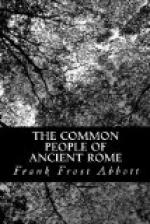We naturally think first of the direct statements made by Latin writers. These are to be found in the writings of Cicero, Quintilian, Seneca the Rhetorician, Petronius, Aulus Gellius, Vitruvius, and the Latin grammarians. The professional teacher Quintilian is shocked at the illiterate speech of the spectators in the theatres and circus. Similarly a character in Petronius utters a warning against the words such people use. Cicero openly delights in using every-day Latin in his familiar letters, while the architect Vitruvius expresses the anxious fear that he may not be following the accepted rules of grammar. As we have noticed above, a great deal of material showing the differences between formal and colloquial Latin which these writers have in mind, may be obtained by comparing, for instance, the Letters of Cicero with his rhetorical works, or Seneca’s satirical skit on the Emperor Claudius with his philosophical writings. Now and then, too, a serious writer has occasion to use a bit of popular Latin, but he conveniently labels it for us with an apologetic phrase. Thus even St. Jerome, in his commentary on the Epistle to the Ephesians, says: “Don’t look a gift horse in the mouth, as the vulgar proverb has it.” To the ancient grammarians the “mistakes” and vulgarisms of popular speech were abhorrent, and they have fortunately branded lists of words and expressions which are not to be used by cultivated people. The evidence which may be had from the Romance languages, supplemented by Latin, not only contributes to our knowledge of the vocabulary of vulgar Latin, but it also shows us many common idioms and constructions which that form of speech had. Thus, “I will sing” in Italian is cantero (=cantar[e]-ho), in Spanish, cantare (=cantar-he), in French, chanterai (=chanter-ai), and similar forms occur in some of the other Romance languages. These forms are evidently made up of the Latin infinitive cantare, depending on habeo ("I have to sing"). But the future in literary Latin was cantabo, formed by adding an ending, as we know, and with that the Romance future can have no connection. However, as a writer in the Archiv has pointed out,[18] just such analytical tense forms as are used in the Romance languages to-day are to be found in the popular Latin sermons of St. Jerome. From these idioms, common to Italian, French, and Spanish, then, we can reconstruct a Latin formation current among the common people. Finally a knowledge of the tendencies and practices of spoken English helps us to identify similar usages when we come upon




